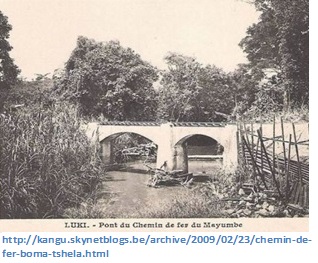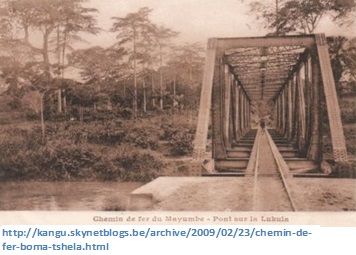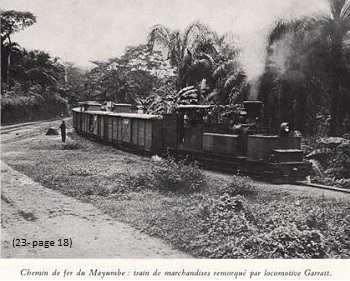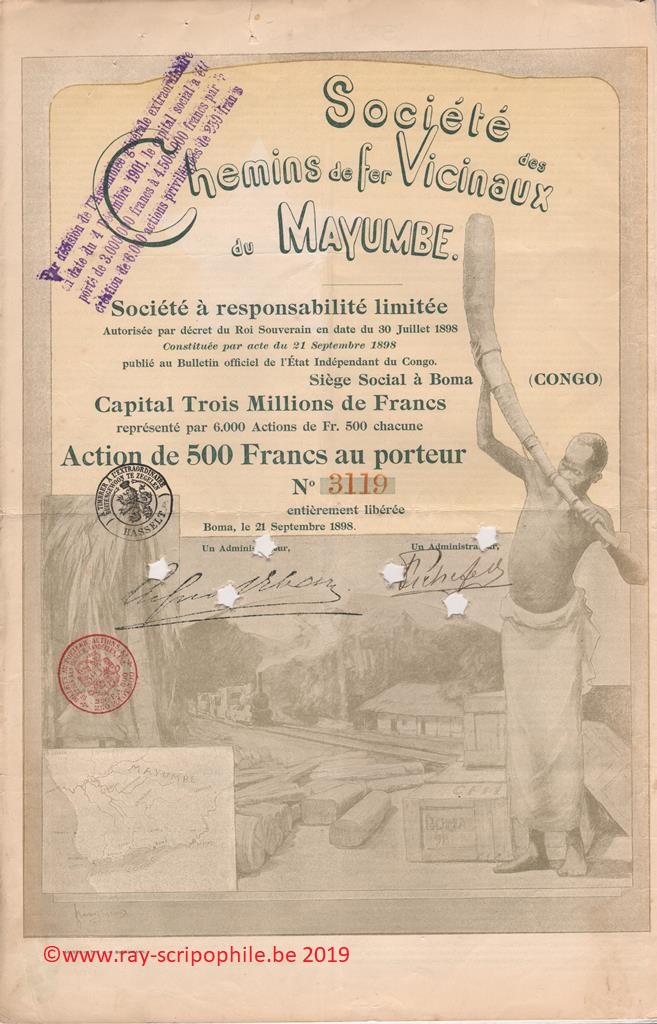Société des Chemins de fer Vicinaux du Mayumbe S.R.L.
Constitution
The share capital of 3 million francs divided into 6,000 shares of 500 francs was subscribed by: The Independent State of Congo for 1 million francs ; the Caisse Commerciale de Bruxelles and the Crédit Général Liégeois for 1 million francs ; An Antwerp group and several Antwerp private individuals for 1 million francs 21-(1900 T1)-71/72).
The Agreement signed on September 21, 1898 by Baron van Eetvelde representing the Independent State of Congo and by Messrs. Alexandre de Browne de Tiège, Léon Collinet, Alfred Orban, Léon Castermans, Alexis Mols and Eugène Fichefet, directors of the Company, stipulated, among other things (30-(1898)-197 to 211) :
Object
- The construction and operation of railways, in accordance with the concessions granted to it by the Government.
- The establishment of crops, the agricultural, commercial, and industrial development of land and the exploitation of mines in the districts of Bas-Congo, in accordance with the concessions granted to it by the Government.
- Any other operation authorized by the Government.
- To make all acquisitions and resales of concessions or movable or immovable property useful or necessary for its trade or industry, to sue in its name, to compromise and to do all acts it deems useful or necessary (1).
Change in capital, event(s), shareholding(s)
1898 - Construction of the line began with a 60-centimeters spacing track typical of the vicinal railways; the machinery was 10 tons; the length of the planned line between Boma-Shiloango was about 140 kilometers (21-(1900 T1)-71/72).
1899 - In May, the Company alienated 100,000 hectares of its land for 4 million francs. The Compagnie Agricole du Mayumbe, then in formation, took 75,000 hectares to cultivate coffee, tobacco, and rubber. The 25,000 hectares remaining to Mr. Fichefet who then transferred them to the Société des Plantations de la Lukula (21-(1923 T1)-1115 to 1117).

1900 - In January, 31 km of track were in operation (Boma-LukiRiver of Province Orientale in the DRC, tributary of the Aruwimi), in August it was at km 43. At the General Assembly of June 1900, the cost of the line was 50,000 francs per km; that the Company received 4 million francs for the land transferred so that it had 7 million francs at its disposal to complete the main line.
Luki: River of Province Orientale in the DRC, tributary of the Aruwimi.
The first coupon (intercalary interest) was paid by 16.25 fb on 2 January 1900 (21-(1900 T1)-71/72).
1901 - The capital was increased to 4,500,000 francs by the creation of 6,000 preferred shares of 250 francs, which were subscribed by the State of Congo to allow the completion of the line.
1904 - The service included a mixed train, Boma-Lukula, every two days, 130 agents, including 10 Europeans, 8 locomotives, 4 carriages, 62 wagons. Mining prospecting continued (21(-1906 T1)-44/45).
1905 - Given its current situation, the company did not seem likely to develop seriously, but it appeared that the extension to the French Congo could give good results (21(-1906 T1)-44/45).
1907 - Pursuant to Article 32 of the specifications and at the request of the Company, the State took over the operation at the Company's risk. The State could renounce to the exploitation every 6 months. The operating income will decrease; the extensions gave nothing. Studies of the mines, where copper was thought to be encountered and which are 175 km. from the line, are suspended. The Company still owns 150,000 francs. L'Agricole du Mayumbe claims 5 million; the lawsuit will be pleaded in Belgium in 1908. 1909, 1910 ...(21-(1910 T1)-40)

1908 - The extension into the French Congo would be an expense of 15 million. The situation was subordinated to the outcome of the Agricole ...(21-(1910 T1)-40).
1910 - The situation improved. The railway operation yielded a final profit of 26,000 francs (21-(1912 T1) -43/44).
1911 - The State built the extension of the line to the north; it planned to reach Benza-Masolo at the end of 1911 and then continue to Tshela. If the State did not continue the construction of the line to the French Congo, which would be a rich mining territory capable of providing important transport, the Company would seek to provide for it (21-(1912 T1)-43/44).
1912 - The actual net profit for 1911 was 129,676.89 francs. The increase in revenue was largely due to transport for the construction of the extension. Major repairs had to be made. The value of the French mining land would have been overestimated (21-(1913 T1) -1010/11).
1913 - The Council is concerned about the solution to be given to the dispute with the Agriculture Minister over land but has not yet made any proposals. The line, whose construction is still under way at State, would have arrived at kilometer 114.
The State considered this sum too high in view of the company's situation and came to the following agreement:
Takeover by the state. - Agreement of July 10, 1913 (not yet approved by the legislative chambers).
At any time, the State could free itself early by capitalizing 3% of the annuities remaining to be paid (21-(1919 T1) -1231).
1914 - During the 1913-14 session, the Chambers had not yet approved the convention (21-(1915 T1)- 1100).
1920 - The accounts for the years 1914 to 1918 could not yet be drawn up. - The pleadings in the lawsuit with l'Agricole took place on January 13 and 14, 1920; the court cancelled the sale of the 43,675 hectares not yet delivered and ordered the Vicinaux to reimburse l'Agricole the sum of 1,747,024 francs, the price it had paid for the land, plus legal interest since 1899, i.e. a total of about 3 million francs. The State buy-back agreement was approved by the law of 21 November 1919 (21-(1920 T1)-1326 to 28). Following the repurchase of the line by the State in 1913, the preference shares were cancelled, and the capital was reduced to 3 million francs. An appeal was lodged (21-(1921 T1)-1224 to 26).
1921 - On June 6, the court dismissed the Company's appeal. Proposals were presented to the Agricultural for an amicable and transactional execution. In the absence of an agreement, the appeal remains open. The claim against the State was not yet settled until the initial date of entry into the new regime had been fixed: the State argued that the assignment agreement should be applied as of 1 January 1914, whereas the Company considered that it would only take effect from the date of its ratification by the Chambers, which was not until 1919, and that, for the interim period, the State owed operating revenues rather than annual repurchase payments (21-(1922 T1) -1495).
Dividends and cotation
|
Dissolution and liquidation
In 1922, an agreement was reached with l'Agricole. The latter took over the assets of the Vicinaux and cleared the liabilities. In order to do this, Société Agricole de Mayumbe increased its capital by 590,500 francs by creating 1,181 shares of 500 francs each, which were remitted, together with the 534 shares in the Vicinaux portfolio, to Crédit Général Liégeois in order to be allocated to the holders of shares in Société des Chemins de Fer Vicinaux du Mayumbe. The latter waived its appeal in cassation and was put into liquidation on June 26,1922 (21-(1923 T1)-1115 to 17).
The shares were exchanged on January 2, 1923 based on seven Société des Chemins de Fer Vicinaux shares for two Société Agricole du Mayumbe shares (21-(1925 T2)-1127).

The 114 km long railway line from Boma to Tshela, owned by the Colony, was operated by the Régie du Chemin de Fer du Mayumbe. In 1935, the operation was entrusted to OTRACO; the Régie was dissolved the same year (23-page 5).
At the end of 1946, the Chemin de Fer du Mayumbe employed Garratt locomotives of 27.5 tons, 226 miscellaneous wagons (22-page 58).


